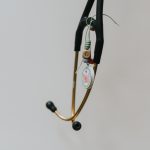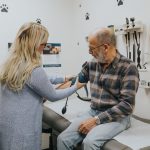Share
Highlighting the role of physician assistants in Alberta’s healthcare system
Back to MessengerRead time: 3 minutes
CPSA began formally regulating physician assistants (PAs) in April 2021. Physician Assistants are trained healthcare providers who work under the supervision of a physician. PAs work in a variety of clinical team settings to complement existing services and help improve patient access to quality health care.
In March 2024, the University of Calgary launched a Master of Physician Assistant Studies program, the first of its kind in the province. To celebrate the launch of this program and the three-year anniversary of PA regulation in Alberta, we’re revisiting highlights from a 2022 interview with Hannah, a PA in Edmonton.
| Read the complete two-part series in the April 2022 edition of The Messenger. |
How do PAs interact with and contribute to the overall healthcare team?
We act as an extension of our physician team to fill in gaps and help improve patient care. For instance, I work in a large academic centre with a team of residents, as well as attending physicians. I fill in the gaps when residents are in the operating room by covering things on the ward and helping with consults or procedures. This allows the residents to spend more time learning surgical skills. This varies depending on the exact role of the PA, though.
What are some of the possible environments in which a PA can work?
Physician assistants always collaborate with a fully-licensed physician, so a PA can work almost anywhere a physician can. Our role looks different in each situation, but essentially our scope of practice mirrors that of our supervising physician. This can include learning and performing specialty-specific procedures, taking on more in the operating room or seeing patients more autonomously, and is all negotiated between the physician and the PA. If there are tasks that one or both parties aren’t comfortable with, there’s flexibility to focus on other tasks or to pursue further training.
Since PAs can work in multiple specialities simultaneously, it’s important to understand that the PA scope of practice reflects that of their current supervising physician. For instance, if a PA is performing skin biopsies in a dermatology specialty, they can’t perform that skill in internal medicine unless skin biopsies are also a part of the latter physician’s practice.
How is your role different now than it was before PAs were formally regulated by CPSA?
Prior to regulation, PAs could practise in Alberta and could voluntarily register with CPSA as non-regulated members. Since regulation, many of our skills and capabilities have been clarified through documents such as the Health Professions Act (HPA), allowing for increased efficiency and autonomy within the PA-physician relationship. For example, all orders given by a PA working in a hospital setting prior to regulation—ordering medication, labs or asking for vital signs at a particular interval—needed to be co-signed by the attending physician. Now, within an established PA-physician relationship, PAs can put in their own orders, which ultimately makes things more efficient.
Since PAs are newer to regulation in Alberta, have you encountered any misconceptions about your role?
There are definitely some misconceptions about what we do and having the word ”assistant” in our title can make things a little bit confusing. There’s often the misconception that physician assistants are more like medical assistants or secretaries as opposed to being clinical practitioners. Fortunately, this is often easily clarified once we can demonstrate our skills and show Albertans how we can help.
How can PAs impact the quality of care Albertans receive?
PAs can help improve the efficiency of the healthcare team. We can serve as an extra set of hands to reduce wait times, reduce the length of hospital admissions and help address patient concerns quicker for higher patient satisfaction.
PAs can also improve consistency and continuity of care. In a hospital setting, for example, a PA may look after the same patient for the entirety of their stay, meaning the patient has an extra source of education and advocacy tailored to their needs.
What’s your favourite thing about being a PA?
I value being able to walk alongside patients in their care. I love the way the profession emerged from a need for continuity, filling gaps and breaking through some of the barriers that exist in health care—for instance, getting more practitioners to remote rural areas or helping to shorten patient wait times. I also appreciate always having a mentor, my supervising physician, whose expertise I can draw upon to ensure high quality patient care.
The flexibility of the role is a neat piece, too. For example, I have several colleagues who split their time working in two different specialities; we have the professional capacity to move laterally and explore different aspects of patient care.
Where can physicians go if they’re looking for more information or they want to contact a PA?
Physicians who are interested in connecting with PAs can reach out through the Canadian Association of Physician Assistants (CAPA), through the CAPA Alberta representative or through PAs they meet (we’re quite well connected and most are happy to help).
Related News
All News & EventsJuly 25, 2024
Alberta Evacuation Information
April 11, 2024
Medical Matters: Quality improvement at CPSA
April 11, 2024
Continuing medical education and professional development opportunities – April 2024
April 11, 2024




















Comments for this post are now closed. If you would like to share your feedback on this topic, please email support@cpsa.ca.